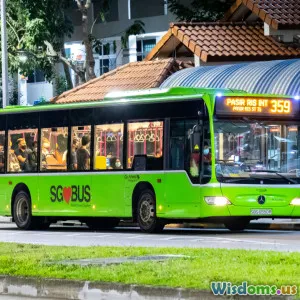
Ten Data Points Showing Public Transit Reduces Urban Air Pollution
9 min read Explore ten compelling data points that prove how public transit significantly reduces urban air pollution, improving city life and health. (0 Reviews)
Ten Data Points Showing Public Transit Reduces Urban Air Pollution
Introduction
Imagine a bustling city where the air is clean, the streets less congested, and the skies visibly clearer. It might seem like a futuristic vision, but data from around the world reveal a very attainable truth: public transit is one of the most powerful tools cities can use to reduce urban air pollution. In many metropolitan areas, the dominance of private vehicles has long been a major contributor to unhealthy air quality, exacerbating respiratory diseases, environmental degradation, and climate change. Public transit offers a promising solution by reducing the number of cars on the road, lowering harmful emissions.
This article delves deep into ten data points—real, quantifiable evidence—that highlight the role of public transit in cutting down air pollution in urban environments. From decreased emissions to health improvements, these statistics not only show the benefits but also underscore why investing in and expanding public transportation infrastructure is vital for sustainable urban living.
1. Public Transit Reduces Per Capita Carbon Emissions by Significant Margins
Studies from the American Public Transportation Association (APTA) reveal that public transit reduces carbon dioxide emissions by approximately 45 million metric tons annually in the U.S. alone. This translates to a 37 million-ton reduction compared to if those commuters had traveled by private vehicles. On average, individuals who use public transit produce 45% fewer carbon emissions than those commuting by car.
For example, New York City's extensive subway and bus systems prevent an estimated 1 million tons of greenhouse gas emissions each year.
2. One Bus Replaces Multiple Cars, Slashing Emission Concentrations
A single bus can replace as many as 30 to 50 cars on the road during peak hours. This directly leads to lowered concentrations of Nitrogen Oxides (NOx) and particulate matter (PM2.5), both key pollutants affecting respiratory health.
For instance, Los Angeles’ Metro Bus system removes approximately 44 cars from roads per bus during rush hour, cumulatively reducing local NOx emissions in the region.
3. Urban Areas with More Transit Options Exhibit Reduced Ground-Level Ozone
Ground-level ozone forms when pollutants like NOx and volatile organic compounds (VOCs) react under sunlight. Cities with comprehensive public transit networks, such as Tokyo and Paris, have reported statistically lower concentrations of ozone despite high population densities.
A 2019 study published in the Environmental Science & Technology Journal found that cities investing in transit experienced up to 15% lower ozone levels compared to similar cities dominated by private car use.
4. Public Transit Users Drive 40% Fewer Vehicle Miles Traveled (VMT)
A report by the Victoria Transport Policy Institute found that shifting to public transit reduces individual vehicle miles traveled by 40%. This key metric correlates directly with reduced emissions. Less time on the road means less fuel consumption, lowering overall air pollution.
San Francisco's Bay Area Rapid Transit (BART) system contributors cut total regional vehicle use substantially, directly mitigating smog build-up during peak travel times.
5. Heavy Investment in Transit Infrastructure Correlates with Measurable Air Quality Improvements
Cities that have invested heavily in transit infrastructure also boast measurable reductions in nitrogen oxide and particulate levels. Seoul, South Korea, after upgrading their subway and bus expanse from 2000 to 2015, recorded a 20% improvement in urban air quality based on government environmental monitoring.
6. Transit-Oriented Development Cuts the Need for Lengthy Commutes
When cities design neighborhoods around public transit hubs—a concept called Transit-Oriented Development (TOD)—commuting distances shrink dramatically. Reduced commutes mean fewer emissions and less urban smog.
Seattle’s TOD initiatives have decreased average commuter distances by up to 10%, contributing not only to lower car emissions but also decreased traffic congestion and better air quality.
7. Electric and Hybrid Transit Fleets Further Slash Pollution
An increasing number of cities are electrifying their transit fleets. Shenzhen, China, operates the world’s first fully electric bus fleet—16,000 buses—cutting carbon emissions by over 1.35 million tons annually and nearly eliminating tailpipe-based particulate matter pollution across the city.
European cities like Amsterdam and Oslo are following suit, investing in hybrid and zero-emission buses to further improve air quality.
8. Public Transit Improves Public Health Outcomes Linked to Air Quality
A clear link exists between public transit use and lower incidences of asthma and chronic respiratory disease due to improved air quality. Research published in the American Journal of Preventive Medicine estimates that neighborhoods with better transit access see 10-15% fewer asthma-related emergency room visits.
Better air quality translates into tangible public health and economic benefits from lower healthcare costs.
9. Reduced Parking Demand Creates Urban Greenspace That Cleans Air
By encouraging public transit, cities lower the need for sprawling parking lots, which often create heat islands exacerbating pollution. With fewer parking spaces, cities can convert these areas into parks and green corridors that absorb pollutants like PM2.5 and ozone.
Philadelphia’s recent initiatives around park creation near transit hubs yielded local pollutant drops by 5% in those zones.
10. Global Data Illustrates Transit’s Role in Meeting Climate Action Goals
In alignment with the Paris Agreement, numerous cities report that transit expansion is pivotal to their carbon reduction targets. For example, London’s Ultra Low Emission Zone (ULEZ), bolstered by improved bus and rail services, reduced roadside nitrogen dioxide (NO2) pollution by 44% within two years.
This evidence underscores public transit as a linchpin in combating urban pollution and global climate change.
Conclusion
The data is unequivocal: public transit systems aren't just about convenience or reducing traffic — they are vital tools in the fight against urban air pollution. From slashing greenhouse gas emissions to improving respiratory health, transit acts as a powerful force shaping cleaner, healthier cities. Investing in public transit infrastructure, electrifying transit fleets, and promoting transit-oriented development form a trifecta of strategies that urban policymakers must prioritize if we are to live in cities with breathable air and sustainable futures.
From New York’s massive subway system to Shenzhen’s electric buses, these ten data points illustrate not just a trend but a global imperative. The cleaner air we breathe tomorrow hinges on actions taken today to expand and improve public transit.
Before choosing your mode of transport tomorrow, remember the impact: every trip by bus or train is a small but powerful step toward a cleaner, healthier urban world.
Rate the Post
User Reviews
Popular Posts



















